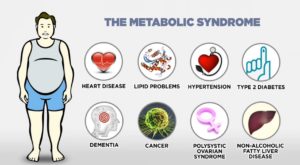METABOLIC-SYNDROME
 Metabolic syndrome is a group of conditions that occur together, increasing risk of heart disease, stroke and type 2 diabetes. These conditions include increased blood pressure, high blood sugar, excess body fat around the waist, and abnormal cholesterol or triglyceride levels. Having just one of these conditions doesn’t mean person has metabolic syndrome. But it does mean they have a greater risk of serious disease.
Metabolic syndrome is a group of conditions that occur together, increasing risk of heart disease, stroke and type 2 diabetes. These conditions include increased blood pressure, high blood sugar, excess body fat around the waist, and abnormal cholesterol or triglyceride levels. Having just one of these conditions doesn’t mean person has metabolic syndrome. But it does mean they have a greater risk of serious disease.
if they develop more of these conditions, risk of complications, such as type 2 diabetes and heart disease, rises even higher. Metabolic syndrome is increasingly common, and up to one-third of adults have it. If patients have metabolic syndrome or any of its components, aggressive lifestyle changes can delay or even prevent the development of serious health problems.
Symptoms:
Most of the disorders associated with metabolic syndrome don’t have obvious signs or symptoms. One sign that is visible is a large waist circumference. And if blood sugar is high, might notice the signs and symptoms of diabetes — such as increased thirst and urination, fatigue, and blurred vision.
Causes:
Metabolic syndrome is closely linked to overweight or obesity and inactivity.
It’s also linked to a condition called insulin resistance. Normally, digestive system breaks down the foods you eat into sugar. Insulin is a hormone made by pancreas that helps sugar enter cells to be used as fuel.
In people with insulin resistance, cells don’t respond normally to insulin and glucose can’t enter the cells as easily. As a result, your blood sugar levels rise even as your body churns out more and more insulin to try to lower your blood sugar.
Diagnosis:
According to latest Indian guidelines, metabolic syndrome is diagnosed when a patient has at least 3 of the following 5 conditions:
- Fasting glucose ≥100 mg/dL (or on treatment)
- Blood pressure ≥130/85 mm Hg (or on treatment)
- Triglycerides ≥150 mg/dL (or on treatment)
- HDL-C < 40 mg/dL in men or < 50 mg/dL in women (or on treatment)
Waist circumference ≥90 cm (35 in) in men or ≥80 cm (32 in) in women
Treatments:
If aggressive lifestyle changes such as diet and exercise aren’t enough, might need medications to help control your blood pressure, cholesterol, and blood sugar levels.
Lifestyle changes
making healthy lifestyle changes can help prevent or delay serious health problems, such a heart attack or stroke. A healthy lifestyle includes.
Regular physical activity
It is recommended to get at least 30 minutes of exercise, such as brisk walking, daily. Look for ways to increase activity any chance you get, such as walking instead of driving and using the stairs instead of an elevator.
Weight loss
Losing atleast 10 percent of body weight can reduce insulin resistance and blood pressure and decrease risk of diabetes. It is also important to maintain weight loss. If you are struggling with taking off weight and keeping it off, options might be available, such as medications or bariatric surgery.
Healthy diet
Healthy-eating plans, such as the Dietary Approaches to Stop Hypertension (DASH) diet and the Mediterranean diet, emphasize eating:
- Vegetables
- Fruits
- High-fibre whole grains
- Lean protein
And healthy-eating plans tend to recommend limiting:
- Sugar-sweetened beverages
- Alcohol
- Salt
- Sugar
- Fat, especially saturated fat and trans fat
Stopping smoking
Stopping cigarettes greatly improves your overall health.
Reducing or managing stress
Physical activity, meditation, yoga and other programs can help you handle stress and improve emotional and physical health.
The following factors increase chances of having metabolic syndrome:
- Age.
- Ethnicity Indians are more at risk.
- Obesity.
- Diabetes.
- Other diseases. non-alcoholic fatty liver disease, polycystic ovary syndrome or sleep apnoea.
- Type 2 diabetes : If patients do not make lifestyle changes to control excess weight, may develop insulin resistance, which can cause blood sugar levels to rise. Eventually, insulin resistance can lead to type 2 diabetes.
- Heart and blood vessel disease: High cholesterol and high blood pressure can contribute to the build-up of plaques in arteries. These plaques can narrow and harden arteries, which can lead to a heart attack or stroke.
A lifelong commitment to a healthy lifestyle may prevent the conditions that cause metabolic syndrome. A healthy lifestyle includes:
- Getting at least 30 minutes of physical activity most days.
- Eating plenty of vegetables, fruits, lean protein and whole grains.
- Limiting saturated fat and salt in diet.
- Maintaining a healthy weight.
- Not smoking.